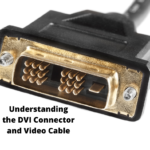Welcome to our comprehensive guide on the VGA port and its role in display interfaces. In this article, we will explore the VGA connector, analog signals, VGA cables, and more. Whether you’re a tech enthusiast or simply looking to understand the basics, we’ve got you covered. So, let’s dive in and unravel the mysteries of the VGA port.
Key Takeaways:
- The VGA port is a widely used display interface that uses analog signals.
- VGA connectors have 15 pins and are known for blending colors on the screen.
- VGA cables are becoming less popular with the rise of digital standards like HDMI and DVI.
- VGA ports come in different variations, such as VGA-15 and VGA-9, with varying resolutions.
- With the transition to digital signals, VGA connections are being replaced by digital interfaces.
What Does a VGA Connector Look Like?
A VGA connector is a commonly used interface for video output, especially on older devices. It features a distinctive trapezoid shape and is equipped with 15 pins that facilitate the transmission of analog signals. Understanding the physical appearance of a VGA connector is important for connecting devices and ensuring a secure connection.
The VGA connector is divided into a male connector and a female port. The male connector is typically found at the end of a VGA cable, while the female port is located on the display device. The male connector has two screws on either side that align with two screw holes on the female port, allowing for a stable and secure connection. The female port, on the other hand, has 15 holes that correspond to the 15 pins on the male connector.
To visualize the appearance of a VGA connector, refer to the image below:

| Component | Description |
|---|---|
| VGA connector | A trapezoid-shaped connector used for video output. |
| Male connector | Found on the VGA cable and features two screws for secure attachment. |
| Female port | Located on the display device and has 15 holes that match the pins on the male connector. |
| Pins | There are 15 pins within the male connector that facilitate the transmission of analog signals. |
Summary
A VGA connector is easily identifiable by its trapezoid shape and 15 pins. The male connector, found on the VGA cable, features two screws for secure attachment, while the female port, located on the display device, has 15 holes that correspond to the pins on the male connector. This physical design ensures a reliable and stable connection between the VGA cable and the display device.
Why Do VGA Connectors Have Tiny Pins?
VGA connectors have tiny pins because each pin serves a specific function in the VGA connection. These pins are responsible for transmitting the primary colors of red, green, and blue, which are used to create all the other colors on the display. Additionally, the intensity of these colors can be changed, resulting in a 16-color scheme. The tiny pins also include grounding pins that help prevent signal interference, ensuring a clear and stable connection.
Two specific pins, known as pins 13 and 14, control the horizontal and vertical synchronization, respectively. These synchronization pins are responsible for ensuring that the two halves of the display are synchronized and match seamlessly. By carefully coordinating the timing and alignment of the display, VGA connectors deliver a smooth and accurate visual experience.
Overall, the tiny pins on VGA connectors play a crucial role in transmitting the necessary signals and maintaining the integrity of the connection. Their design and functionality contribute to the vibrant colors, clear images, and synchronized display that VGA technology offers.

Table: VGA Connector Pins and Functions
| Pin Number | Function |
|---|---|
| 1-3 | Red |
| 4-6 | Grounding |
| 7-9 | Green |
| 10-12 | Grounding |
| 13 | Horizontal Synchronization |
| 14 | Vertical Synchronization |
| 15 | Blue |
| Other Pins | Grounding and Reserved Functions |
What Kind of Variations of the VGA Ports Are There?
VGA ports come in different variations, primarily distinguished by the number of pins they have. The most common type is VGA-15, also known as DE-15, which features 15 pins arranged in three rows. This is the standard VGA port found on most devices, including computer monitors, televisions, and video cards. Each of the 15 pins serves a specific function in the VGA connection, contributing to the overall display quality.
Another variation is VGA-9, which has only nine pins. This smaller VGA port is primarily used for laptops and handheld devices where space is limited. While VGA-9 ports are less common than VGA-15 ports, they can still be found on certain devices. It’s important to note that despite the difference in pin count, the same VGA cable can be used for both VGA-15 and VGA-9 ports.
VGA Port Resolutions
The resolution supported by a VGA port depends on the capabilities of the computer’s video card. While VGA is often associated with lower resolutions, it is capable of supporting higher resolutions in theory. However, practical limitations such as the need for digital-to-analog conversion and the processing power required can affect the actual resolution achievable through a VGA port. Most video cards that support VGA offer resolutions up to 1080p, but older devices may have lower resolution capabilities.
The quality of the VGA cable can also impact the display resolution. Factors such as cable length, coaxial shielding, and overall build quality can affect the signal integrity and ultimately the display quality. Using a high-quality VGA cable can help ensure optimal performance and resolution support.
| VGA Port Variation | Number of Pins | Common Applications |
|---|---|---|
| VGA-15 (DE-15) | 15 | Computer monitors, televisions, video cards |
| VGA-9 | 9 | Laptops, handheld devices |
In summary, VGA ports have different variations, such as VGA-15 and VGA-9, distinguished by the number of pins they have. VGA-15 is the most common type and is found on most devices, while VGA-9 is smaller and primarily used for laptops and handheld devices. The resolution supported by a VGA port depends on the computer’s video card and can vary from 1080p to higher resolutions depending on the capabilities of the hardware. The quality of the VGA cable also plays a role in the display resolution and overall performance.
Analog to Digital: The Transition and Implications for VGA
The transition from analog to digital signals has had significant implications for VGA cables and their usage in modern display interfaces. With the rise of digital signals, VGA cables, which transmit in analog, have become less prevalent in the industry. This shift has been driven by the advantages of digital signals, such as improved image quality and higher resolutions.
VGA cables require digital-to-analog conversion, which can impact the picture quality and require processing power from the computer. This means that VGA connections are not ideal for high resolutions and are being replaced by digital interfaces, such as HDMI and DisplayPort, which natively support digital signals.
The move towards digital interfaces has also resulted in a decrease in the availability of VGA ports on newer devices. While VGA may still be present on some legacy devices, the industry is moving towards digital display interfaces, leaving VGA with a niche role in the display interface landscape.

Table: Comparison of Analog VGA and Digital Interfaces
| Aspect | Analog VGA | Digital Interfaces (HDMI, DisplayPort) |
|---|---|---|
| Signal Type | Analog | Digital |
| Image Quality | Dependent on digital-to-analog conversion | Natively digital, resulting in improved image quality |
| Resolution Support | Limited by conversion and processing power | Higher resolutions supported, such as 4K and 8K |
| Availability | Becoming less prevalent on newer devices | Standard on modern devices |
Can VGA Connections Support High Resolutions?
When it comes to VGA connections, the maximum resolution supported depends on the capability of the video card in your computer. While VGA theoretically has the potential to support higher resolutions, there are limitations that affect its practical resolution. The need for digital-to-analog conversion and the processing power required can hinder the ability to achieve high resolutions through VGA connections.
Most video cards that support VGA typically offer a maximum resolution of 1080p, which is commonly known as Full HD. This resolution is suitable for many applications, but it falls short compared to the higher resolutions supported by other display interfaces like HDMI and DisplayPort.
Older devices may not support resolutions higher than 1080p at all. It’s worth noting that the specific resolution capabilities of VGA ports can vary depending on the computer and its video card. Therefore, if you require high resolutions for your display, it is advisable to consider using digital interfaces that are designed to handle higher resolutions more efficiently.
| VGA Resolution | Video Card Capability |
|---|---|
| 1080p (Full HD) | Most common maximum resolution for VGA connections |
| Higher resolutions | Limited by the need for digital-to-analog conversion and processing power |
| Older devices | May not support resolutions higher than 1080p |

Despite its limitations in terms of resolution, VGA connections still play a role in certain applications and for users with older devices that feature VGA ports. Understanding the capabilities and limitations of VGA can help you make informed decisions when it comes to choosing the appropriate display interface for your specific needs.
What Is the Difference Between HDMI and VGA?
When it comes to display interfaces, HDMI and VGA are two commonly used options. However, there are significant differences between the two in terms of the signals they use, resolution support, and bandwidth capabilities.
HDMI, or High-Definition Multimedia Interface, utilizes digital signals to transmit both audio and video data. This enables a more efficient and higher-quality transmission compared to VGA, which uses analog signals. The digital nature of HDMI allows for sharper images, vibrant colors, and clearer audio, making it the preferred choice for modern devices.
VGA, on the other hand, relies on analog signals and requires a digital-to-analog conversion to transmit video data. This conversion process can impact the picture quality and requires processing power from the computer. As a result, VGA connections have certain limitations, particularly when it comes to resolution support. While HDMI supports high resolutions, such as 8K at 120hz, VGA’s resolution is restricted by the need for conversion and the available processing power. HDMI also offers a higher bandwidth, allowing for faster data transfer rates compared to VGA.
| Feature | HDMI | VGA |
|---|---|---|
| Signal Type | Digital | Analog |
| Resolution Support | High (up to 8K at 120hz) | Limited by conversion and processing power |
| Bandwidth | Higher | Lower |
| Audio Transmission | Supported | Not supported (requires additional cables) |
Overall, HDMI provides a more advanced and versatile solution for modern display needs, offering better image quality, higher resolutions, and enhanced audio capabilities. However, VGA connections still have their place, particularly for older devices and legacy hardware that feature VGA ports. Despite its limitations, VGA remains a reliable and cost-effective choice for certain applications. It’s important to consider the compatibility of your devices and the specific display requirements when choosing between HDMI and VGA.
VGA to HDMI Converters: Bridging the Gap Between Older Monitors and Modern Devices
If you have an older monitor with a VGA port and want to connect it to a device that only has HDMI output, a VGA to HDMI converter is the solution you need. These converters allow you to bridge the gap between VGA and HDMI, allowing you to utilize your older display with newer devices. By converting the analog VGA signal to digital HDMI, you can enjoy the benefits of modern connectivity without having to invest in a new monitor.
One important thing to note is that VGA cables do not transmit audio, so most VGA to HDMI converters also feature a 3.5mm audio jack for audio transmission. This ensures that you can enjoy both high-quality video and audio when using the converter. The audio can be connected directly to the HDMI output device, such as a TV or soundbar, providing a seamless multimedia experience.
It’s worth mentioning that VGA connections have their limitations, especially when it comes to resolution support. VGA’s maximum resolution is limited to 2K, and the conversion process from analog to digital can impact picture quality. However, for many users with older monitors or specific connectivity needs, a VGA to HDMI converter provides a practical and cost-effective solution.

| VGA to HDMI Converter Benefits | VGA Limitations |
|---|---|
|
|
VGA to HDMI converters are a convenient tool for users who want to connect their older VGA monitors to newer HDMI devices. They offer a simple and affordable way to bridge the gap between analog and digital, providing a smooth and seamless user experience. While VGA may have its limitations, a VGA to HDMI converter ensures that you can continue using your trusted monitor while enjoying the benefits of modern connectivity.
Compatibility Considerations
When choosing a VGA to HDMI converter, it’s important to consider the compatibility of both your monitor and your HDMI device. Ensure that the converter supports the specific resolutions and refresh rates required by your monitor and that it is compatible with the HDMI version of your device. Additionally, consider the length of the HDMI cable required for your setup, as longer cables may introduce signal degradation. By carefully selecting a compatible converter, you can seamlessly integrate your older monitor into your modern device setup.
In conclusion, VGA to HDMI converters provide a bridge between older VGA monitors and modern HDMI devices, allowing users to enjoy the benefits of digital connectivity while continuing to use their existing displays. While VGA may have limitations in terms of resolution and audio transmission, converters offer a cost-effective solution for users who want to repurpose their older monitors. By considering compatibility and the specific needs of your setup, you can choose a converter that meets your requirements and ensures a seamless transition from analog to digital.
Converters: DVI & VGA
When it comes to display interfaces, DVI connectors offer a versatile option that supports both analog and digital signals. This makes them a popular choice for connecting various devices, including monitors, projectors, and televisions. The ability to handle both analog and digital signals gives DVI connectors an advantage over VGA connectors, which only support analog signals. With a DVI connector, you have the flexibility to connect to a wide range of devices and enjoy high-quality video output.
If you need to connect a device with a VGA port to a device with a DVI port, you can use a VGA to DVI adapter. This adapter allows you to convert the VGA signal to DVI and maintain compatibility between the two interfaces. It’s important to note that the adapter may result in a decrease in display quality, as the VGA signal is being converted to digital. However, for those who need to bridge the gap between VGA and DVI, the adapter provides a convenient solution.
When choosing a display interface, it’s essential to consider your specific needs and requirements. While DVI connectors offer compatibility with both analog and digital signals, HDMI and DisplayPort have become the industry standards for digital video transmission. These interfaces provide higher resolutions, increased bandwidth, and support for advanced features like audio transmission. However, for those with legacy devices or specific display requirements, VGA to DVI adapters can help bridge the gap and ensure seamless connectivity.
Table: Comparison of DVI and VGA Connectors
| Feature | DVI Connectors | VGA Connectors |
|---|---|---|
| Signal Type | Analog and Digital | Analog |
| Resolution Support | Up to 2560×1600 | Up to 1920×1200 |
| Compatibility | Compatible with DVI, HDMI, and VGA (with adapter) | Compatible with VGA (with adapter) |
| Audio Transmission | Supports audio over HDMI (with adapter) | N/A |
| Availability | Becoming less common as industry transitions to digital interfaces | Still featured on some devices, especially legacy hardware |
When it comes to choosing the right display interface, it’s important to weigh your options and consider the specific requirements of your devices. While DVI connectors offer the versatility of supporting both analog and digital signals, VGA to DVI adapters can bridge the gap between older devices with VGA ports and newer devices with DVI ports. By understanding the differences between these connectors and considering your display needs, you can make an informed decision and ensure seamless connectivity.
VGA vs Mini-VGA
When it comes to display interfaces, VGA and its smaller counterpart, mini-VGA, offer options for different devices and connectivity needs. Mini-VGA, as the name suggests, is a smaller version of the standard VGA port. This smaller size makes mini-VGA ports popular in laptops and other compact devices where space is a premium. If you have a laptop with a mini-VGA port and want to connect it to a standard VGA display, you can use an adapter to bridge the size difference and ensure compatibility.
One of the key advantages of mini-VGA is its compatibility with laptops. Many older laptops feature mini-VGA ports, and using this interface allows you to connect to VGA displays without the need for additional converters. This makes it a convenient option for retro computer hobbyists or anyone working with older laptops that still have mini-VGA ports.
“With mini-VGA, I can easily connect my vintage laptop to my VGA monitor and enjoy the nostalgic experience of using the original hardware,” says John, a retro computer enthusiast.
However, it’s important to note that mini-VGA ports are not as common as standard VGA ports. While you can find adapters to connect mini-VGA to VGA displays, the availability of these adapters may vary depending on your location and specific device requirements. Additionally, mini-VGA ports may have limitations in terms of display resolution and functionality compared to standard VGA ports. It’s always recommended to check the specifications of your devices and adapters to ensure compatibility and optimal performance.
| VGA | Mini-VGA |
|---|---|
| Standard size | Smaller size |
| Widely used | Primarily found in older laptops and compact devices |
| Easy connectivity with VGA displays | Requires adapter for VGA display connection |
| Higher resolution support | May have limitations on resolution and functionality |
Overall, the choice between VGA and mini-VGA depends on the specific device and connectivity requirements. Standard VGA ports are more common and offer broader compatibility with VGA displays. On the other hand, mini-VGA ports are favored for their smaller size and are often found in older laptops. Whether you’re a retro computer hobbyist or working with compact devices, understanding the differences and considerations between VGA and mini-VGA can help you make informed decisions for your display interface needs.
The Future of VGA
As technology continues to advance, the future of VGA may seem uncertain. However, despite the rise of modern digital display interfaces, VGA still has a place in the world of legacy devices and compatibility. While it may not be as prevalent as it once was, VGA continues to offer a cost-effective solution for connecting older computers, monitors, and other hardware.
One of the key advantages of VGA is its compatibility with a wide range of devices. Many older computers and monitors still feature VGA ports, making it easy to connect and use legacy hardware without the need for adapters or converters. This compatibility ensures that VGA remains a viable option for individuals who rely on older devices or have specific equipment requirements.
Granted, VGA does have its limitations compared to modern digital interfaces. Its resolution support is lower, and the need for digital-to-analog conversion can impact image quality. However, when used for the appropriate applications and with the right equipment, VGA can still deliver satisfactory results.

“VGA still has a place in the world of legacy devices and compatibility.”
While VGA may not be at the forefront of display interface technology, it will likely continue to have a niche role in the years to come. Its affordability and compatibility make it an attractive choice for certain users, particularly those who utilize older computers or need to connect legacy hardware. As long as there is a need for VGA’s unique capabilities, it will persist as a reliable option for display connectivity.
In summary, while the future of VGA may not be as flashy as its digital counterparts, it still offers a practical solution for legacy devices and compatibility. As technology evolves, VGA will continue to serve a niche role, providing a cost-effective and reliable option for those in need. So, while the spotlight may be on modern display interfaces, let’s not forget the enduring power of VGA.
Conclusion
In conclusion, understanding the function of VGA is key to optimizing your tech experience. Despite being an older technology, VGA still offers several benefits. Firstly, it provides improved graphics quality, allowing for vibrant and lifelike visuals on your display. Additionally, VGA offers high-resolution support, allowing you to enjoy sharp and detailed images on compatible devices.
Furthermore, VGA ensures seamless connectivity with a wide range of devices. Whether you have an older computer, monitor, or even a retro gaming console, VGA ports are commonly found, making it easy to connect and enjoy your favorite content.
Lastly, VGA remains a cost-effective choice for those with older devices and legacy hardware. While newer display interfaces like HDMI and DisplayPort have emerged, VGA continues to be a reliable and accessible option for many users.
In summary, when considering display interfaces for your computer system, it’s important to weigh factors such as graphics quality, resolution support, and connectivity. VGA may not be the cutting-edge technology it once was, but it still has a valuable place in the world of display interfaces.
FAQ
What does a VGA connector look like?
A VGA connector is shaped like a trapezoid and has 15 pins. The male connector, which is found on the VGA cable, has two screws on either side that correspond to two screw holes on the female port.
Why do VGA connectors have tiny pins?
VGA connectors have tiny pins because each pin serves a specific function in the VGA connection. The first three pins are responsible for red, green, and blue, which are the primary colors used to create all the other colors on the display.
What kind of variations of the VGA ports are there?
VGA ports come in different variations, such as VGA-15 and VGA-9. VGA-15, also known as DE-15, is the most common type and features 15 pins arranged in three rows, while VGA-9 has only nine pins and is primarily used for laptops and handheld devices.
What is the difference between HDMI and VGA?
HDMI uses digital signals, allowing for more efficient and higher-quality transmission of both audio and video data. VGA, on the other hand, uses analog signals and requires digital-to-analog conversion to transmit video data.
Can VGA connections support high resolutions?
The resolution of a VGA connection depends on the video card in the computer. The highest resolution supported by VGA ports is 2K, but in theory, VGA could support higher resolutions.
What is the future of VGA?
While VGA has become less prevalent on modern devices, it still has a place due to the presence of older computers and monitors that feature VGA ports. However, the industry is moving towards digital display interfaces, such as HDMI and DisplayPort.















